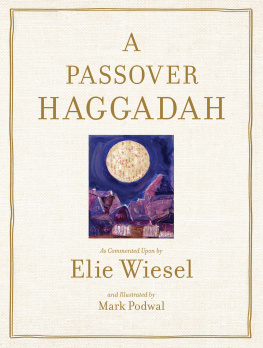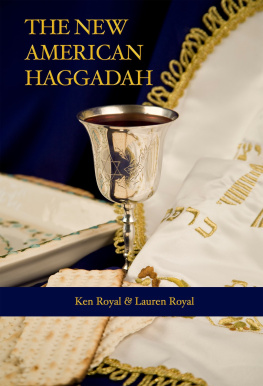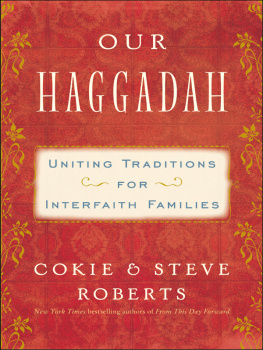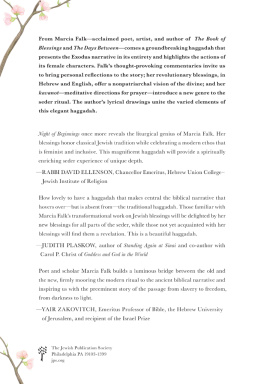
LIVES OF GREAT RELIGIOUS BOOKS
The Passover Haggadah
LIVES OF GREAT RELIGIOUS BOOKS
The Passover Haggadah, Vanessa L. Ochs
Josephuss The Jewish War, Martin Goodman
The Song of Songs, Ilana Pardes
The Life of Saint Teresa of Avila, Carlos Eire
The Book of Exodus, Joel S. Baden
The Book of Revelation, Timothy Beal
The Talmud, Barry Scott Wimpfheimer
The Koran in English, Bruce B. Lawrence
The Lotus Stra, Donald S. Lopez, Jr.
John Calvins Institutes of the Christian Religion, Bruce Gordon
C. S. Lewiss Mere Christianity, George M. Marsden
The Bhagavad Gita, Richard H. Davis
The Yoga Sutra of Patanjali, David Gordon White
Thomas Aquinass Summa theologiae, Bernard McGinn
The Book of Common Prayer, Alan Jacobs
The Book of Job, Mark Larrimore
The Dead Sea Scrolls, John J. Collins
The Book of Genesis, Ronald Hendel
The Book of Mormon, Paul C. Gutjahr
The I Ching, Richard J. Smith
The Tibetan Book of the Dead, Donald S. Lopez, Jr.
Augustines Confessions, Garry Wills
Dietrich Bonhoeffers Letters and Papers from Prison, Martin E. Marty
The Passover Haggadah
A BIOGRAPHY
Vanessa L. Ochs
PRINCETON UNIVERSITY PRESS
Princeton and Oxford
Copyright 2020 by Princeton University Press
Requests for permission to reproduce material from this work should be sent to
Published by Princeton University Press
41 William Street, Princeton, New Jersey 08540
6 Oxford Street, Woodstock, Oxfordshire OX20 1TR
press.princeton.edu
All Rights Reserved
Library of Congress Cataloging-in-Publication Data
Names: Ochs, Vanessa L., author.
Title: The Passover Haggadah : a biography / Vanessa Ochs.
Other titles: Lives of great religious books. Description: Princeton, New Jersey : Princeton University Press, 2020. | Series: Lives of great religious books | Includes bibliographical references and index.
Identifiers: LCCN 2019030565 (print) | LCCN 2019030566 (ebook) | ISBN 9780691144986 (hardcover) | ISBN 9780691201528 (epub)
Subjects: LCSH: HaggadahHistory. | HaggadotTextsHistory and criticism.
Classification: LCC BM674.79 .O33 2020 (print) | LCC BM674.79 (ebook) | DDC 296.4/5371dc23
LC record available at https://lccn.loc.gov/2019030565
LC ebook record available at https://lccn.loc.gov/2019030566
British Library Cataloging-in-Publication Data is available
Editorial: Fred Appel and Jenny Tan
Production Editorial: Debbie Tegarden
Production: Erin Suydam
Publicity: Kathryn Stevens
Copyeditor: Dawn Hall
Jacket image: Barbara Wolff, Ma Nishtanah, from the Rose Haggadah, 2014. Collection of The Morgan Library and Museum, New York (MS.M. 1191).
This book has been composed in Garamond Premier Pro
Printed on acid-free paper.
Printed in the United States of America
10 9 8 7 6 5 4 3 2 1
For Harry, Emma, and Isaiah
CONTENTS
LIST OF ILLUSTRATIONS
LIVES OF GREAT RELIGIOUS BOOKS
The Passover Haggadah
The Life of the Haggadah
INTRODUCTION
When I began to think hard about the life of the Haggadah in preparation for this biography, Rabbi Lawrence Hoffman, who has written extensively on this text, suggested I go to Chicago and meet Stephen Durchslag, the premier private collector of the printed Haggadah in America. Im glad I did, because shortly after my arrival, I learned how the Haggadah lived in a distinctive way.
The father of anthropological fieldwork is Bronislaw Malinowski, who distinguished himself from the armchair anthropologists of the nineteenth century by leaving home and going into the field for an extended period to live among the people who would be the objects of his study; in those days, they were invariably called the natives. Malinowskis description of his arrival in Melanesian New Guinea is well known. Imagine yourself, Malinowski wrote, suddenly set down surrounded by all your gear, alone on a tropical beach close to a native village, while the launch or dinghy which has brought you sails away, out of sight. The entrance story foreshadows the anthropologists transformation from stranger to insider. It also hints at essential understandings that will be revealed. While anthropologists today rarely claim they have become insiders, performing fieldwork remains their primary research method and is the professions initiation rite. They still tell entrance stories, so, nodding to Malinowski, I preface this biography with my own.
I arrived along the shore of Lake Michigan, neither by launch nor by dinghy, but by car. This was Chicagos Gold Coast, and I stood in front of the grand building where Mr. Durchslag, who had invited me to call him Steve, lived, hoping I was presentable. It was an unusually sunny and hot fall day. When I entered his modern, art-filled apartment overlooking the city and the lake, he graciously offered me a drink. I said, Water will be lovely. I felt awe and excitement as Steve ushered me into his wood-shelved library where his Haggadot were housed. (In Hebrew, the plural of Haggadah is Haggadot; still, many people say Haggadahs, an Anglicized mash-up of the Yiddish plural, hagodes.) Rare ones were just there on the shelves, not even behind glass, but placed along with his other books, even paperbacks. He selected treasures to show me, rapidly placing one on top of the next on a glass display table in the center of the room. Here was the 1629 Venice Haggadah, the 1695 Amsterdam Haggadah, and now the 1712 Amsterdam with its fold-out map of the biblical world. I could hardly keep up. Steve didnt insist I coddle each Haggadah on a special foam rest as I had in libraries rare books collections; this was liberating, but what if I stressed the binding? He didnt ask me to put on those special white gloves the special collections librarians made me wear. I could have been perusing my very modest shelf of stacked up Haggadot in my living room, a collection rich in the super-market and Maxwell House coffee Haggadot my mother had amassed over years, not as exemplars of ephemera, but for us to use. I was anxious for the safety of Steves booksdidnt they need a more watchful eye, some protection, say, from me?
Distracting myself from these worrisome thoughts, I asked Steve how he had found his Haggadot, thinking he might have some miraculous discovery stories. He answered by matter-of-factly pulling off a Sothebys catalog and then one from Kestenbaums from his shelves; he pointed to a new purchase that was still in an unopened padded mailer, and he said more new ones were on their way. The tower of Haggadot he was piling on the table for me grew higher. Haggadot from Poona (Pune), Paris, South Africa, Shanghai, Melbourne, Munich. He declared it was time to clear off this batch to make space for others.
Inebriated by gratitude to be present to witness this wondrous collection, I enthusiastically stretched out my right arm over the books on the table, ready to help sweep them up so I could see even more rare Haggadot.
I had failed to notice that on this hot day, Steve had also gotten himself a drink, a bottle of diet cola, and it had been on the table all along, and it was uncapped. Now, thanks to my outstretched arm, it was spilling all over the table of Haggadot. I prayed: Oh dear God, if the soda damages just the Sothebys catalogthat would be enough. Or just the Sothebys and also, the Kestenbaums; even that would be enough.
I started to turn toward Steve, anticipating his horror and displaying my shame, but during my liturgical interlude, he had dashed off and returned with what he called a
Next page







